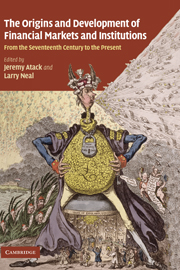 The Origins and Development of Financial Markets and Institutions
The Origins and Development of Financial Markets and Institutions Published online by Cambridge University Press: 04 August 2010
Most of the papers in this volume (Chapters 2–7 and 9–14) were presented at a conference on “The Development of Financial Institutions and Markets,” held April 28–29, 2006 at the University of Illinois at Urbana-Champaign. The purpose of the conference was to celebrate the contributions of Larry Neal upon the occasion of his retirement from active teaching at the University of Illinois. Financial historians who had interacted with Professor Neal over his career at Illinois, several of them former students of Larry's, were invited to contribute an original paper in their current area of research. Individually, the papers showcase the variety of approaches and theories that continue to motivate scholars in financial history. Together, they demonstrate various aspects of financial innovation and the evolution of financial institutions over time, which has been the focus of Neal's teaching and research for three decades.
Chapters 1, 8 and 15 were written later and serve to set the scene, recognize the contribution of one of Larry's co-authors, Lance E. Davis, who was not well enough to participate, and emphasize the lessons from these studies of the past for the present and future.
Discussants on each paper provided a perspective and began broader discussion of the issues raised in each among the audience. These included (listed alphabetically): Michael Bordo (Rutgers University), Charles Calomiris (Columbia University), Ann Carlos (University of Colorado and University College, Dublin), Conception Garcia-Iglesias (University of Helsinki), Charles Kahn (University of Illinois), Joseph Mason (Drexel University), and Maria Valderama (National Bank of Austria).
To save this book to your Kindle, first ensure [email protected] is added to your Approved Personal Document E-mail List under your Personal Document Settings on the Manage Your Content and Devices page of your Amazon account. Then enter the ‘name’ part of your Kindle email address below. Find out more about saving to your Kindle.
Note you can select to save to either the @free.kindle.com or @kindle.com variations. ‘@free.kindle.com’ emails are free but can only be saved to your device when it is connected to wi-fi. ‘@kindle.com’ emails can be delivered even when you are not connected to wi-fi, but note that service fees apply.
Find out more about the Kindle Personal Document Service.
To save content items to your account, please confirm that you agree to abide by our usage policies. If this is the first time you use this feature, you will be asked to authorise Cambridge Core to connect with your account. Find out more about saving content to Dropbox.
To save content items to your account, please confirm that you agree to abide by our usage policies. If this is the first time you use this feature, you will be asked to authorise Cambridge Core to connect with your account. Find out more about saving content to Google Drive.